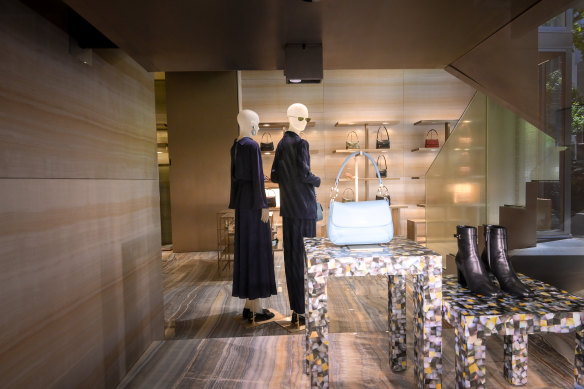Our Terms & Conditions | Our Privacy Policy
Chanel struts into collapsed rival Harrolds’ flagship store
Management at 101, which is owned by the Commonwealth super fund, declined to comment.
The luxury brand earlier this year paid a thumping $75 million to buy the Flinders Lane building that houses its 10-year-old boutique where it retails $10,000-plus handbags and shoes. It did not respond to questions from this masthead, but the new Collins Street lease will allow it to continue trading while it rejigs its existing Flinders Street premises.
Luxury giants have been hit by slowing global sales, surprising investors and prompting fears of a recession in the sector.Credit: Justin McManus
By contrast, Harrolds’ 700 square metre storefront, and its high-end fitout, in the Sydney Westfield luxury mall stands closed and empty.
The mall, owned by retail property behemoth Scentre Group, is considered Sydney’s home of luxury. Harrolds is one of the few stores not trading in the centre where occupancy is at 99.4 per cent.
Unlike some global counterparts, rents in Pitt Street plateaued this year, Cushman’s ranking shows, reflecting a cost-of-living crisis confronting the nation’s shoppers.
Loading
Savills retail services director Leighton Hunziker said luxury retail is facing pressure from the slowdown in tourism, particularly out of China.
“Luxury brands have in some cases shelved plans to come, whilst others have put a brake on capex spending and yet others have decided to hand back space or seek alternate retailers to assign the lease to. This is making it challenging for landlords with programs exposed to this sector of the market,” Hunziker said.
Luxury giants LVMH (owner of Louis Vuitton, Dior, Tiffany and Moet & Chandon) and Kering Group (owner of Gucci), in the last quarter, were hit by slowing global sales, surprising investors and prompting fears of a recession in the sector.
Despite that, rents in Ginza, Tokyo soared 25 per cent this year, London’s New Bond Street was up 13 per cent, and Milan’s Via Montenapoleone jumped 11 per cent.
Cushman’s head of international research, Dominic Brown, said consumer spending will continue to boost prime retail destinations. “How quickly and strongly that feeds through into rental growth at a market level will vary due to local nuances and market dynamics,” he said.
The Poulakis family are selling two valuable Melbourne properties, a process they started with agency JLL before Harrolds’ collapse.
They own a seven-level building at 301 Flinders Lane that used to be occupied by Victoria University, but was vacated in 2022, which they purchased eight years ago for $34.2 million, about a year after they scooped up a nearby bar at 2 Mill Place for around $4 million.
“301 Flinders Lane and 2 Mill Place are not owned by the entities subject to the liquidator’s appointment. Therefore, they are not available to the liquidator for realisation as part of the liquidation process,” SMB Advisory said.
Savills’ November Retail Investment report says that property investors in Australia are proving resilient and pouring money back into national retail property assets despite business and consumer confidence lagging and delays in much-anticipated interest rate cuts.
“From January to September 2024, investment volumes totalled $6.6 billion – over 80 per cent higher than the same period in 2023 ($3.7 billion),” the note said.
“Inflation eased further in September, and the anticipated monetary policy easing next year is expected to bring pricing expectations closer together supporting a more sustained rebound in activity in 2025,” it said.
The Market Recap newsletter is a wrap of the day’s trading. Get it each weekday afternoon.
Images are for reference only.Images and contents gathered automatic from google or 3rd party sources.All rights on the images and contents are with their legal original owners.



Comments are closed.